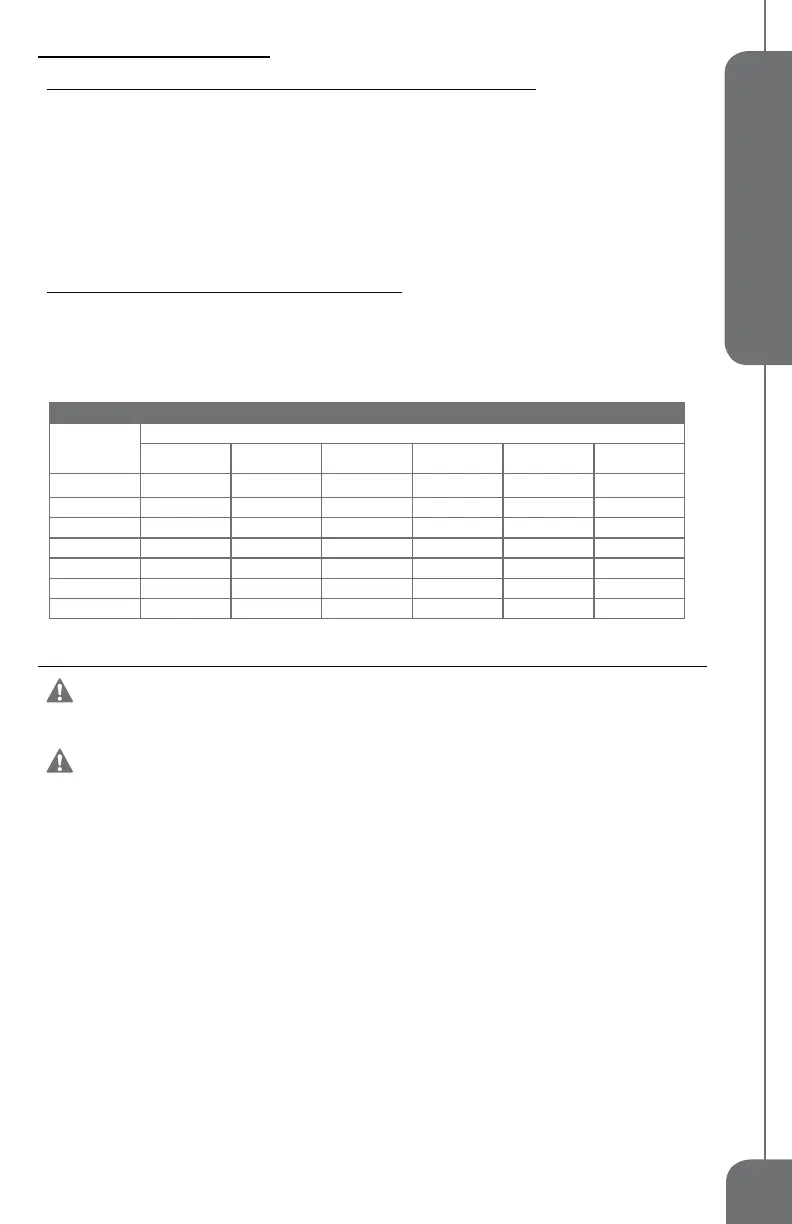5
English
EXTENSION CORDS
Grounded tools require a three wire extension cord. Double insulated tools can
use either a two or three wire extension cord. As the distance from the power supply outlet increases, you must
use a heavier gauge extension cord. Using extension cords with inadequately sized wire causes a serious drop
in voltage, resulting in loss of power and possible tool damage. Refer to the table shown below to determine the
required minimum wire size.
The smaller the gauge number of the wire, the greater the capacity of the cord. For example: a 14-gauge cord
can carry a higher current than a 16-gauge cord. When using more than one extension cord to make up the total
length, be sure each cord contains at least the minimum wire size required. If you are using one extension cord
for more than one tool, add the nameplate amperes and use the sum to determine the required minimum wire
size.
Guidelines for Using Extension Cords
• If you are using an extension cord outdoors, be sure it is marked with the suffix “W-A” (“W” in Canada) to
indicate that it is acceptable for outdoor use.
• Be sure your extension cord is properly wired and in good electrical condition. Always replace a damaged
extension cord or have it repaired by a qualified person before using it.
• Protect your extension cords from sharp objects, excessive heat, and damp or wet areas.
SPECIFIC SAFETY RULES FOR PLUNGE CIRCULAR SAWS
WARNING: DO NOT LET COMFORT OR FAMILIARITY WITH PRODUCT
(GAINED FROM REPEATED USE) REPLACE STRICT ADHERENCE TO PRODUCT SAFETY
RULES. If you use this tool unsafe or incorrectly, you can suffer serious personal injury!
WARNING: Hold tool by insulated gripping surfaces when performing an
operation where cutting tools may contact hidden wiring or its own cord. Contact with a
“live” wire will make exposed metal parts of the tool “live” and shock the operator!
• DANGER!
Keep hands away from cutting area and blade.
Keep your body positioned
to either side of the saw blade, but not in line with the saw blade. KICKBACK could cause the saw to jump
backwards. (See “Causes and Operator Prevention of Kickback”) Do not reach underneath the work. The
guard cannot protect you from the blade below the work. Do not attempt to remove cut material when blade
is moving.
CAUTION:
Blades coast after turn off. Wait until blade stops before grasping cut material.
• Check the operation and condition of the lower guard spring.
If the guard and the
spring are not operating properly, they must be serviced before use. Lower guard may operate sluggishly due
to damaged parts, gummy deposits, or a buildup of debris.
• Always observe that the lower guard is covering the blade
before placing saw down
on bench or floor. An unprotected, coasting blade will cause the saw to walk backwards, cutting whatever is
in its path. Be aware of the time it takes for the blade to stop after switch is released.
• Never hold piece being cut in your hands or across your leg. It is important to
support the work properly to minimize body exposure, blade binding, or loss of control.
Recommended Minimum Wire Gauge for Extension Cords (120 Volt)
Nameplate
Amperes
(At Full Load)
Extension Cord Length
25 Feet 50 Feet 75 Feet 100 Feet 150 Feet 200 Feet
0–2.0 18 18 18 18 16 16
2.1–3.4 18 18 18 16 14 14
3.5–5.0 18 18 16 14 12 12
5.1–7.0 18 16 14 12 12 10
7.1–12.0 18 14 12 10 8 8
12.1–16.0 14 12 10 10 8 6
16.1–20.0 12 10 8 8 6 6
